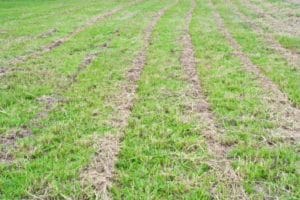Capital Press (this link is no longer available)
By Sean Ellis

FRUITLAND, Idaho — The message of a field day that highlighted the use of cover crops to suppress weeds and improve soil health was that what works in organic farming can work in conventional fields as well.
The four-hour field day was held at Hamanishi Farms in southwest Idaho. The operation produces 1,000 acres of conventional mint, alfalfa, wheat, onions, corn and beans and 70 acres of organic mint, alfalfa and wheat.
“Anything that appears to work and is proving itself as being cost-effective on the organic side, we’re taking it back to the conventional side,” Hamanishi Farms Manager Jon Fabricius told a couple dozen people during a half-day tour June 27.
With fuel, fertilizer and chemical costs continuing to increase, it’s critical for farmers to find cost-effective ways to reduce their usage of these inputs as much as possible, Fabricius said.
“The forecast is that the price on everything is just going to be more volatile in the future and (meanwhile) you have these great big price swings in ag commodity prices,” he said. “We’re trying to use these methods as an insulator against volatility.”
Examples of cover crops that have worked at Hamanishi Farms include sorghum-sudan grass that was grown to about 7 feet and then worked into the ground in an old orchard that didn’t have a history of producing good crops, Fabricius said.
“We saw good response in the crops after that,” he said, adding that similar results were seen in an Austrian winter pea/triticale mix in the farm’s over-winter onion program.
“We saw a much better stand coming out of the winter,” he said. “I think there was better nutrient availability and the onions were just in a lot better condition coming out of winter.”
The farm also experienced good results with the planting of buckwheat following over-winter onions to prepare for mint planting.
“The guy we planted mint with couldn’t believe how soft and mellow the soil was,” Fabricius said.
Hamanishi Farms owner George McClelland explained how the use of cover crops has significantly improved soil health at the farm.
“As the cost of petroleum and fertilizer increases, it’s getting more important to start taking advantage of Mother Nature and the nutrients that can develop that way,” he said. “The key to the survival of the farm is building healthy soils.”
To accomplish that, he said, it’s important to use a variety of cover crops and to try to have something growing on every acre year-round.
During the field day, University of Idaho researchers also discussed some of the cover crop work they have been doing in high-desert farming systems of 3,700-5,100 feet common in southern Idaho.
Some cold-hardy cover crops that are promising the greatest winter survival include hairy vetch, winter cereal crops, Austrian winter peas and clovers. Varieties that can be used for spring, summer or fall planting include buckwheat, canola, oilseed radish, mustards, turnips, clovers, warm-season annuals and chickling vetch.

